During an interview in 2009, Google’s Chief Economist, Hal Varian, quoted, “The ability to take data – to be able to understand it, to process it, to extract value from it, to visualize it, to communicate it – is going to be a hugely important skill in the next decades.”
Fast forward to 2023, and US businesses can’t get enough of data and data-driven decision making. As new cloud data solutions flood the market, the industry beholds the rise of two formidable contenders: Databricks and Snowflake.
Today’s businesses eagerly seek platforms that streamline data analytics and provide security and ease of accessibility to users. Considering that, the choice between Databricks vs Snowflake becomes a pivotal decision for companies to make.
Table of Contents
- What Is Databricks?
- Purpose of Databricks
- Core features of Databricks
- Role of Databricks in Data Analytics, Machine Learning, and Data Engineering
- What is Snowflake?
- Purpose of Snowflake
- Core features of Snowflake
- Role of Snowflake in Data Warehousing, Data Sharing, and Analytics
- Databricks vs. Snowflake: A Comparative Analysis
- Databricks and Snowflake: User Communities and Support Insights
- Databricks vs. Snowflake: Making a Future-Proof Decision
- FAQ’s
What Is Databricks?
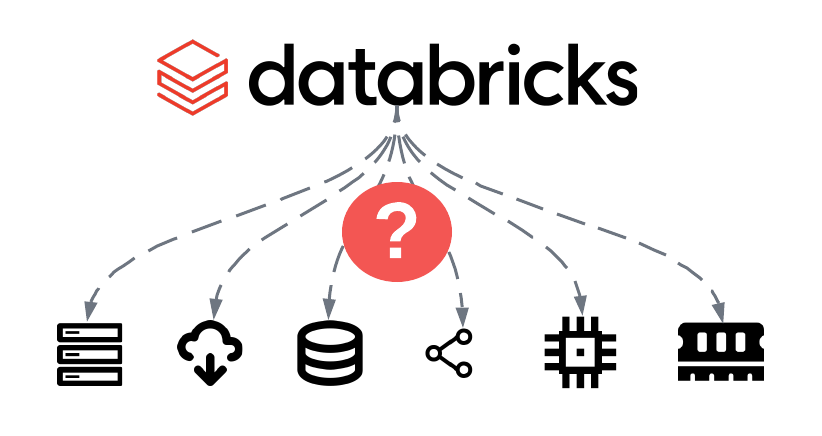
Databricks is a cloud-based, unified analytics platform. Databricks was founded in 2013 by Ali Ghodsi, Matei Zaharia, Reynold Xin, and Ion Stoica. They were also the innovators behind Apache Spark.
Databricks has been designed for creating, deploying, sharing, and maintaining enterprise-level data, analytics, and AI solutions at scale.
Purpose of Databricks
The purpose of Databricks is to make it easier for organizations to build and deploy data-driven applications. Databricks provides a unified platform for data engineering, data science, and machine learning. Therefore, this makes it possible for organizations to get insights from their data faster and more easily.
Core features of Databricks
The platform has a wide range of features for data engineering, data science, and machine learning, including:
- Data Lakehouse Platform: A unified platform for data, analytics, and AI that combines the best of data lakes and data warehouses.
- Apache Spark: Databricks is based on Apache Spark, a unified analytics engine for big data processing.
- Interactive Notebooks: Databricks provides interactive notebooks for data exploration, analysis, and machine learning.
- Collaboration and Sharing: Databricks makes it easy to collaborate and share work within teams and across organizations.
- Managed Infrastructure: Databricks takes care of the underlying infrastructure, so you can focus on your data and analytics.
Role of Databricks in Data Analytics, Machine Learning, and Data Engineering
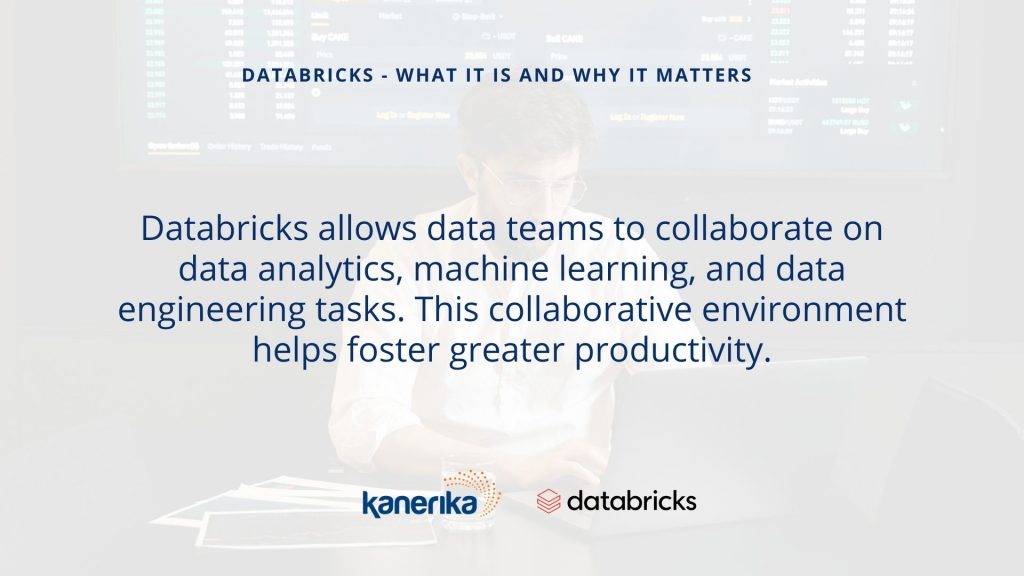
Databricks is a unified analytics platform that provides a single environment for data engineers, data scientists, and machine learning engineers. Moreover, it allows them to collaborate on data analytics, machine learning, and data engineering tasks.
- Data Warehousing: Offers scalable data warehousing solutions for extensive SQL queries
- Data Lakes: Processes and analyzes data in data lakes with diverse languages and tools
- Data Visualization: Presents a range of data visualization tools for comprehensive data understanding
- Collaboration: Promotes team collaboration on data analytics projects through shared workspaces and version control
- Model Development: Equips users with tools and libraries for machine learning model development
- Model Training: A robust platform for training machine learning models on extensive datasets
- Model Deployment: Provides tools for seamless machine learning model deployment to production
Role of Databricks in Data Engineering
- Data Processing: Enables large-scale data processing and transformation using various tools and languages.
- Data Pipelines: Facilitates the construction and management of data pipelines for ETL and ELT tasks.
- Data Quality: Offers tools to maintain data quality.
What is Snowflake?
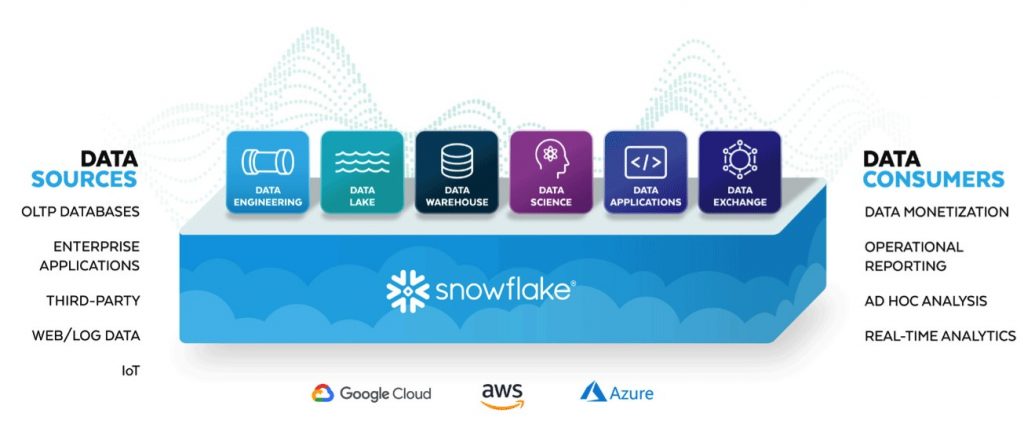
Snowflake is a cloud-based data warehouse that enables organizations to store, process, and analyze all their data at scale.
It is a fully-managed service, so users do not have to worry about managing infrastructure or software. Snowflake is known for its performance, scalability, and security.
Snowflake was founded in 2012 by Benoit Dageville, Marcin Zukowski, and Thierry Cruanes. Additionally, he company has since snowballed into a leading cloud-based data warehouse solution used by global companies.
Purpose of Snowflake
The purpose of Snowflake is to make it easy for organizations to get insights from their data. Snowflake provides a unified platform for data storage, processing, and analytics.
This makes it possible for organizations to get started quickly and to scale as needed.
Core features of Snowflake
Snowflake is a powerful and versatile cloud-based data warehouse that can be used for various tasks. The key features of Snowflake include:
- Performance: Snowflake is designed to deliver high performance for even the most complex workloads.
- Scalability: Snowflake can scale horizontally to meet the needs of any organization.
- Security: Snowflake provides various security features to protect data, including role-based access control, encryption, and auditing.
- Ease of use: Snowflake is easy to use and manage, even for users with limited experience with data warehouses.
Role of Snowflake in Data Warehousing, Data Sharing, and Analytics
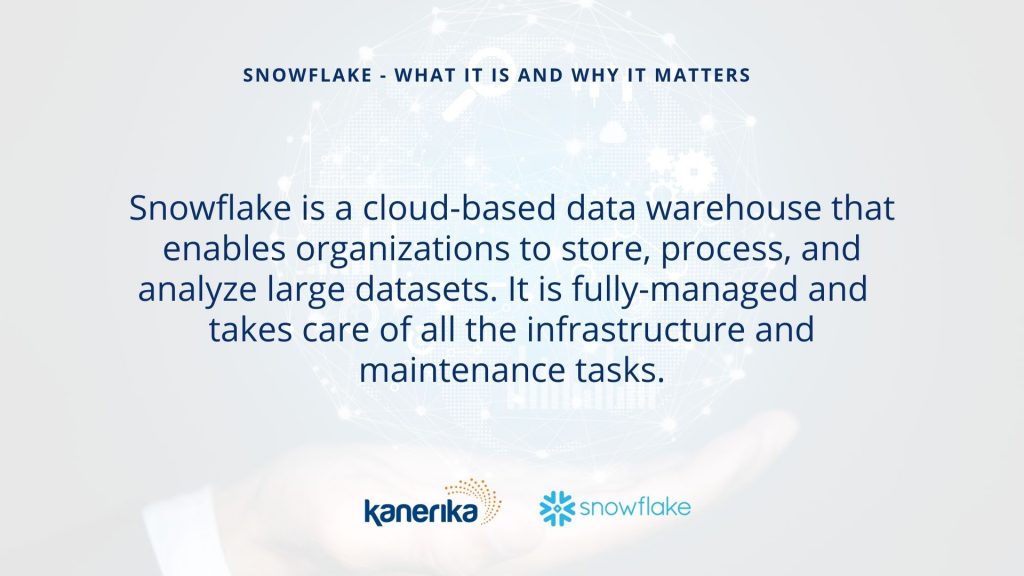
Snowflake is a cloud-based data warehouse that enables organizations to store, process, and analyze large datasets. Moreover, it is a fully managed service, which means that Snowflake takes care of all the infrastructure and maintenance tasks so that organizations can focus on their data and analytics.
- Cloud-Based Architecture: Snowflake offers a cloud-based architecture for data warehousing thus reducing cost
- Data Storage and Query Processing: It provides a robust platform for storing data and executing complex SQL queries
- Automatic Scaling: Snowflake architecture allows resources to be allocated dynamically. Thus, this ensures optimal performance during peak workloads without lag
Role of Snowflake in Data Sharing
- Secure Data Shares: Facilitates secure data sharing with controlled access, promoting cloud-based data analytics
- Data Marketplaces: Enables data monetization or acquisition through its Data Marketplace
Role of Snowflake in Analytics
- SQL Support: Maintains standard SQL support, aligning with other data warehouses
- Integrated Analytics Tools: Houses various analytics tools including data visualization and machine learning libraries
- BI Tool Integration: Harmonizes with other BI tools like Tableau and Power BI, enhancing cloud data warehousing capabilities
Databricks vs. Snowflake: A Comparative Analysis
When considering Databricks and Snowflake, it’s important to delve into the details of each platform’s capabilities. Let’s explore how these platforms stack up against each other.
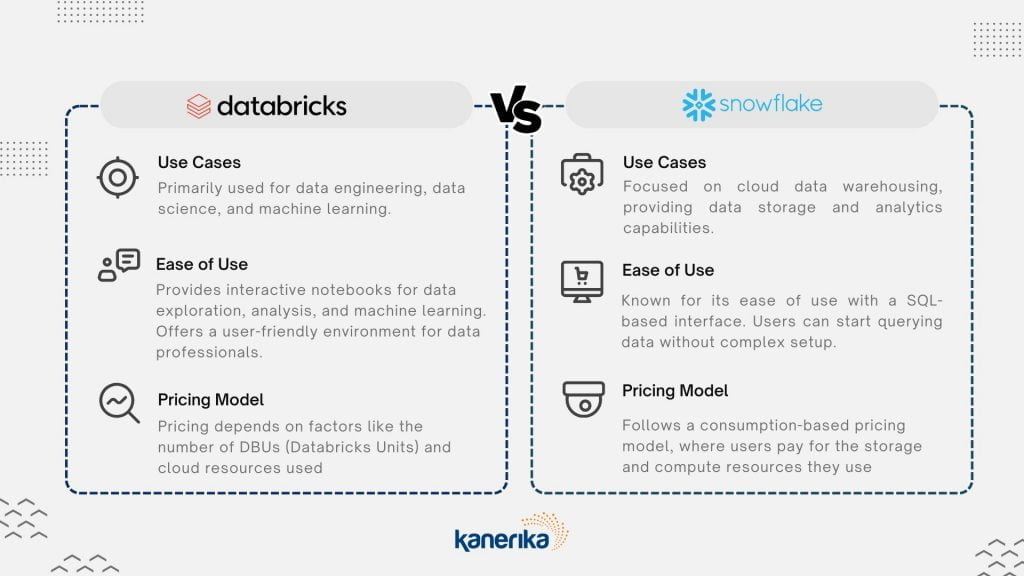
Aspect
|
Databricks
|
Snowflake
|
| Databricks vs. Snowflake Use Cases |
Primarily used for data engineering, data science, and machine learning. Suitable for organizations dealing with big data analytics, AI development, and data processing at scale. |
Focused on cloud data warehousing, providing data storage and analytics capabilities. It’s suitable for businesses looking for a scalable and flexible data warehousing solution. |
| Databricks vs. Snowflake Architecture |
Built on Apache Spark, a unified analytics engine for big data processing. Databricks also offers a unified data platform known as a “Data Lakehouse,” combining data lake and data warehouse functionalities. |
Snowflake has a unique architecture that separates storage and compute, making it highly scalable and elastic. It utilizes cloud-native features for data warehousing. |
| Databricks vs. Snowflake Scalability |
Offers scalability for big data processing, allowing users to scale resources up or down as needed. |
Known for its automatic and elastic scalability, where storage and compute can be independently scaled. |
| Databricks vs Snowflake Ease of Use |
Provides interactive notebooks for data exploration, analysis, and machine learning. Offers a user-friendly environment for data professionals. |
Known for its ease of use with a SQL-based interface. Users can start querying data without complex setup. |
| Databricks vs. Snowflake Integration |
Integrates well with various data sources and cloud platforms, facilitating data pipelines and workflows. |
Offers connectors for popular data integration tools and supports various cloud platforms. |
| Databricks vs Snowflake Performance |
Optimized for data processing tasks, machine learning, and data exploration, providing high-performance capabilities. |
Known for its query performance and automatic optimization features for data warehousing workloads. |
| Databricks vs. Snowflake Security |
Provides security features like encryption, access control, and compliance capabilities. Integrates with various authentication mechanisms. |
Offers robust security measures, including encryption, multi-factor authentication, and compliance certifications. |
| Databricks vs. Snowflake Cost |
Pricing depends on factors like the number of DBUs (Databricks Units) and cloud resources used, making it flexible but potentially complex to estimate. |
Follows a consumption-based pricing model, where users pay for the storage and compute resources they use, providing transparency and flexibility. |
Databricks and Snowflake: User Communities and Support Insights
Databricks and Snowflake have carved a niche in the cloud-based data analytics sector. They both offer robust user communities and customer support options. Let’s discuss them one by one:
1. Databricks:
-
- User Communities: Databricks provides a user community where users can interact with each other, ask questions, share knowledge, and learn from experts.
- Customer Support: Databricks has several plans that provide 24×7 support and timely service for the Databricks platform. You can find more information about their support options on the Databricks Support page.
2. Snowflake:
-
- User Communities: Snowflake also has a community platform where users can connect, collaborate, and share their experiences.
- Customer Support: Snowflake offers comprehensive documentation, online communities, and training resources. They also provide 24/7 live support, which can be beneficial for users requiring immediate assistance.
Please note that the availability of support options may vary based on your specific plans or subscriptions with these platforms. Additionally, it’s always good to refer to their official websites for the most up-to-date information.
Databricks vs. Snowflake: Making a Future-Proof Decision
Snowflake
Snowflake is known for its scalability and adeptly accommodating fluctuations in user numbers and workloads. It maintains optimal performance even during high-demand periods. This allows easy cloud cost optimization. Snowflake eliminates data silos by consolidating information from diverse sources into a unified space.
Databricks
Databricks facilitate data exploration and the development of advanced models and machine learning. Its optimized software manages the machine learning lifecycle adeptly. Furthermore, it promises increased efficiency and cost savings, simplifying resource management and expediting the initiation process.
In essence, Databricks is a reliable cloud data partner, fostering innovation and driving business growth. Choosing Snowflake is a strategic move towards streamlined, efficient, and intelligent data handling.
Kanerika: Your Partner for Databricks and Snowflake Insights

Having the right cloud data platform by your side can be a game-changer for your company in today’s evolving business landscape. Moreover, this is the juncture where the choice between Databricks and Snowflake comes into play, steering your business towards a path of data analytics excellence.
The choice between Databricks and Snowflake boils down to your organization’s specific goals and requirements.
While Databricks seems tailor-made for enterprises venturing into big data analytics and AI, Snowflake aligns seamlessly with the needs of businesses seeking a robust and adaptable data warehousing solution.
Book your free consultation with us today!
FAQ’s
What is Databricks, and what is its purpose?
Databricks is a cloud-based, unified analytics platform founded in 2013. Its purpose is to create, deploy, share, and maintain enterprise-level data, analytics, and AI solutions at scale.
What are the core features of Databricks?
Databricks offers a Data Lakehouse Platform, is based on Apache Spark, provides interactive notebooks, supports collaboration and sharing, and manages underlying infrastructure.
How does Databricks play a role in data analytics, machine learning, and data engineering?
Databricks serves as a unified platform for data professionals, enabling data warehousing, data lakes, data visualization, collaboration, and machine learning model development and deployment.
What are the key differences between Databricks and Snowflake?
Databricks is primarily used for data engineering, data science, and machine learning, while Snowflake focuses on cloud data warehousing. They differ in architecture, scalability, ease of use, integration, performance, security, and pricing.
What is Snowflake, and what purpose does it serve?
Snowflake is a cloud-based data warehouse designed for storing, processing, and analyzing data at scale. Its purpose is to provide a unified platform for data storage, processing, and analytics.
What are the core features of Snowflake?
Snowflake offers high performance, scalability, security, and ease of use. It separates storage and compute, ensuring flexibility.
What are the key factors that businesses should consider when choosing between Databricks and Snowflake?
Businesses should consider factors such as their data analytics goals, scalability requirements, data warehousing needs, and budget constraints when making the choice between Databricks and Snowflake.
What are the advantages of using Databricks for big data analytics and AI?
Databricks is well-suited for enterprises that want to harness the power of big data analytics and AI, offering features for data engineering, data science, machine learning, and more.
How does Snowflake address the data warehousing needs of businesses?
Snowflake is designed to meet data warehousing requirements by providing a scalable, secure, and fully-managed platform for storing, processing, and analyzing data.
What industries or sectors benefit the most from Kanerika's expertise in Databricks and Snowflake?
Kanerika's expertise in Databricks and Snowflake can benefit a wide range of industries, including healthcare, finance, e-commerce, manufacturing, and more. Specific use cases may vary.